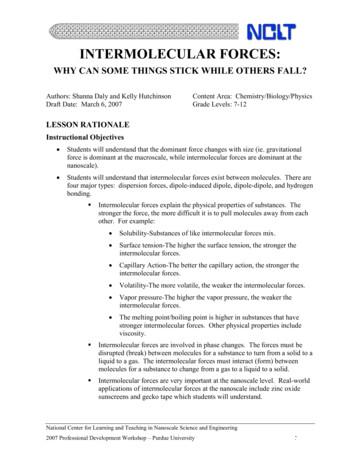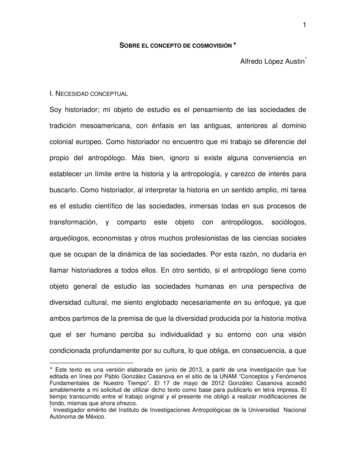Chapter 14 Intermolecular Forces
Chapter 14 – Intermolecular Forces14.1 Types of Intermolecular ForcesWhat is the difference between a bond and an intermolecular force? Bonds: between atoms.This is the force that holds atoms together within amolecule aka intramolecular force. Polar and Nonpolar covalent bonds areexamples of bonds. These bonds are 10X stronger thanintermolecular forces.Intermolecular Force:Between MOLECULESIntermolecular Force (IMF): between molecules.This is the force that holds molecules together. It is aBond: BetweenATOMSform of “stickiness” between molecules. Examples of intermolecular forces areLondon dispersion forces (LDF), dipoledipole forces (DDF), and hydrogen bridging forces (HBF). When we use the word “force” we are referring to intermolecular forces.o London Dispersion Forces (LDF): Sometimes called induced dipole forces or just dispersionforces. Temporary dipole attractions between nonpolar molecules that form due to shiftingelectrons. Electrons can concentrate in one region, which results in a temporary dipole thatdisappears when the electrons shift again. So a temporary partially negative charge, - andpartially positive charge, , forms. This is the only type of IMF between nonpolar molecules. Bigger molecules or atoms usually have stronger dispersion forces. (More electrons)1) Two nonpolar molecules with no attractive forces betweenthem. - -2) As electrons shift within one of the molecules, a temporarydipole may appear. -3) An adjacent molecule will be attracted to the molecule with thetemporary dipole and a new dipole within the second moleculewill be induced. This creates the London dispersion force.4) The electrons move back and the temporary dipoles disappear.This makes the LDF a weak force, it is only temporary.Clark, Smith(CC-BY-SA 4.0)GCC CHM 130Chapter 14: IMFpage 1
o Dipole-Dipole Forces (DDF): A permanent dipole force exists between polar molecules.Attractions form between the partially positive and partially negative ends of adjacent polarmolecules.Image from www.en.wikipedia.org Dipole forces are usually stronger than dispersion forces since the dipoles are permanent. Only polar molecules can form dipole-dipole forces! - - -Note: The opposite dipolesalign themselves to createthe attractive forces.o Hydrogen Bonding Forces (HBF): An especially strong dipole force exists between moleculescontaining H-F, H-O or H-N bonds. (These bonds are highly polar due to the largeelectronegativity difference.) Also called H Bridging Force sometimes. A very strong type of IMF between polar molecules.Hydrogen BridgingForcesImage: www.en.wikipedia.orgo Ion-Dipole Forces (IDF): When an ionic compound such as NaCl dissolves in water, the watermolecules arrange their oppositely charged dipole to be attracted to the fully charged ion,creating a very strong attractive force called an ion-dipole force. Between a polar molecule and a fully charged ion. The partial negative ( -) charge on the water molecule isattracted to the fully charged positive sodium ion (Na ). The partial positive ( ) charge on the water molecule isattracted to the fully charged negative chloride ion (Cl-).Image: www.en.wikipedia.orgClark, Smith(CC-BY-SA 4.0)GCC CHM 130Chapter 14: IMFpage 2
Electrostatic attractive forces that create the ionic bond in NaCl are 10 times stronger than asingle ion-dipole force that is created between the ion and water. Only if enough watermolecules surround the ion creating many, many ion-dipole attractions can the watermolecule pull the ion away from the ionic crystal lattice, dissolving the ionic compound.Image from "Salts", by OpenStax Anatomy and Physiology, CC-BY-NC-SA 4.0.Example. Indicate the strongest type of intermolecular force (LDF, DDF, HBF, or IDF) betweenthe molecules in the following:Polar or Nonpolar?Strongest Intermolecular ForceA. CO2B. PF3C. HFD. CH4E. KBr in H2OAnswers: A) nonpolar, LDF; B) polar, DDF; C) polar; HBF; D) nonpolar, LDF; E) polar, IDFClark, Smith(CC-BY-SA 4.0)GCC CHM 130Chapter 14: IMFpage 3
SummaryBondsIonic bond – holds metal/nonmetal ions togetherPolar Covalent Bond – e- shared unequally between nonmetalsNonpolar Covalent Bond – e- shared equally between nonmetalsForcesLondon Dispersion – nonpolar moleculesDipole-dipole – polar moleculesHydrogen Bonding Force – H bonded to N or O or F within the moleculeIon-Dipole Force – a fully charged ion and a polar molecule. Coulomb’s Law Reviewo Opposite charges attract according to Coulomb’s Law.SNSNOpposite Charges AttractSNNSSame Charges Repelo The electrostatic attraction between two charges is proportional to the charge magnitude (q) andinversely proportional to the distance (r) squared.o F ke(q1q2 / r2)o Larger charge means stronger attraction!o Ionic bonds very strong cause charges are complete 1, 2, 3 charges. Like in NaCl.o Dipole-dipole IMF are much weaker because charges are much less than 1.o Remember polar bonds are only partially and .YouTube Video LDF: https://youtu.be/vwljR1KwbaoYouTube Video DDF: https://youtu.be/dmmy3OklX1YYouTube Video HBF: https://youtu.be/wiUnLDoDIrsYouTube Video Summary of IMF’s: https://youtu.be/S8QsLUO tgQ14.2 How IMF’s affect Properties of LiquidsIntermolecular forces (IMFs) influence various properties of liquids.o Vapor Pressure - The pressure exerted by gas molecules above a liquid.At the surface some molecules of a liquid have enough kinetic energy to break their attractive forceswith neighboring molecules. These molecules escape from the liquid phase and form a gas above thesurface of the liquid. If there’s a lid, pressure develops.In the picture to the right, which liquid has the weakerIMF?(A) because there is more gas meaning liquid (A) isbreaking away from the liquid state easier than (B)thus the IMF must be weaker in (A) than (B). (A)molecules are less attracted to each other than in (B).Clark, Smith(CC-BY-SA 4.0)GCC CHM 130Chapter 14: IMFpage 4
Stronger intermolecular forces lower vapor pressure stronger attractions are harder to break so less gas forms above liquid (B) Weaker intermolecular forces higher vapor pressure weaker attractions are easier to break so more gas forms above liquid (A)o Boiling point (bp): Temperature at which a liquid changes to gas.Boiling occurs when the vapor pressure of a liquid equals theatmospheric pressure. Stronger intermolecular forces higher BP A higher boiling point means more energy is required toboil the liquid. Its harder for molecules to break away fromeach other due to strong attractions.Image: www.en.wikipedia.orgo Surface tension: Attraction between surface molecules in a liquid.Attractive forces at the surface pull molecules inward causing surfacemolecules to be held more tightly. This is why liquids form beads ordrops when sprayed. Stronger intermolecular forces higher surface tension Surface tension of water is high enough that bugs can walkon water.Image: www.en.wikipedia.orgo Viscosity: the resistance of a liquid to flow.e.g. honey flows slowly high viscosity;gasoline flows rapidly low viscosity. Stronger intermolecular forces higher viscosityImage: CC BY-NC 7914.3 Properties of WaterElectron dot formula for H2O: Two bonding electron pairs.Two non-bonding (lone) electron pairs. H2O has a bent molecular geometry with bond angle of 109.5 Water has highly polar O-H bonds: can dissolve ionic compounds and mix with other polarsubstances Water has strong H bonding forces between molecules resulted in observed physical propertiesdiscussed below.Clark, Smith(CC-BY-SA 4.0)GCC CHM 130Chapter 14: IMFpage 5
Physical Properties of Water Very polar, high IMF High bp and mp: bp 100 C, mp 0 C High surface tension, Low vapor pressure Water expands as it freezes Density of ice is less than density of liquid water (rare)Molecular Crystal Structure of Ice. Hydrogenbridging forces attract the H2O molecules to oneanother as ice forms creating a larger volume. As aresult the density of ice is less than the density ofliquid water. Image from www.en.wikipedia.orgImage of a snowflake. Viewedthrough an optical microscope.Image from www.en.wikipedia.org.14.4 Heating-Cooling CurveBe able to indicate the following on a heating curve: Regions for solid only, liquid only, gas only, solid-liquid, liquid-gas Where melting, freezing, boiling, and condensation occur Location of Melting point and Boiling pointGasTemperature (ºC)BPLiquidMPSolidHeat Added Clark, Smith(CC-BY-SA 4.0)GCC CHM 130Chapter 14: IMFpage 6
CHAPTER 14 PRACTICE PROBLEMSExample 1. Indicate the strongest type of intermolecular force (Dispersion, Dipole-Dipole or Hydrogen bond)between the molecules in the following:Polar or Nonpolar?Strongest Intermolecular ForceA. CCl4B. NH3C. HClD. OF2Example 2. Choose the bond or attraction described for each below: IMFs are attractions between molecules.Bonds hold atoms together in a molecule.A. polar covalent bondE. dispersion forceIMF?Y or NB. nonpolar covalent bondF. dipole-dipole forceType(A-G)C. ionic bond D. metallic bondG. hydrogen bonding forceDescription of bond or attractive force1. What is holding the atoms together in an HF molecule2. What is holding two Br2 molecules together in Br2(l).3. What is holding the ions together in CuCl2.4. What is holding two H2O molecules together.5. What is holding the atoms together in a sample of Cu.6. What is holding the atoms together in an O2 molecule.7. What is holding two OF2 molecules together.Example 3. Water molecules experience hydrogen bonding while hexane molecules experience dispersionforces. Circle true or false for the following statements.A. Water’s intermolecular forces are weaker than hexanes.TFB. Hexane has a higher vapor pressure than water.TFC. Hexane has a lower boiling point than water.TFD. Water has a higher surface tension than hexane.TFE. Water has lower viscosity than hexane.TFF. Water has higher molar heat of vaporization than hexane.TFClark, Smith(CC-BY-SA 4.0)GCC CHM 130Chapter 14: IMFpage 7
Answers to Practice ProblemsExample 1.Polar or Nonpolar?Strongest Intermolecular ForceA. CCl4NonpolarDispersion (or London)B. NH3PolarH bondC. HClPolarDipoleD. OF2PolarDipoleExample 2. Choose the bond or attraction described for each below:A. polar covalent bondE. dispersion forceB. nonpolar covalent bondF. dipole-dipole forceC. ionic bond D. metallic bondG. hydrogen bonding forceIMF?Y or NNType(A-G)A1. What is holding the atoms together in an HF moleculeYE2. What is holding two Br2 molecules together in Br2(l).NC3. What is holding the ions together in CuCl2.YG4. What is holding two H2O molecules together.ND5. What is holding the atoms together in a sample of Cu.NB6. What is holding the atoms together in an O2 molecule.YF7. What is holding two OF2 molecules together.Description of bond or attractive forceExample 3:A False, B True, C True, D true, E false, F trueClark, Smith(CC-BY-SA 4.0)GCC CHM 130Chapter 14: IMFpage 8
intermolecular forces. Intermolecular Force (IMF): between molecules. This is the force that holds molecules together. It is a form of “stickiness” between molecules. Examples of intermolecular forces are London dispersion forces (LDF), dipole-dipole forces (DDF), and hydrogen bridging forces (HBF).File Size: 832KB
AP Chemistry Chapter 11. Intermolecular Forces, Liquids, and Solids - 1 - Chapter 11. Intermolecular Forces, Liquids, and Solids 11.2 Intermolecular Forces Intermolecular forces are much weaker than ionic or covalent bonds (e.g., 16 kJ/mol versus 431 kJ/mol for HCl). Melting o
Mar 06, 2007 · intermolecular forces. Volatility-The more volatile, the weaker the intermolecular forces. Vapor pressure-The higher the vapor pressure, the weaker the intermolecular forces. The melting point/boiling point is higher in substances that have stronger intermolecular forces. Other physical properties include viscosity.File Size: 556KB
Intermolecular Forces 1. Evidence for Intermolecular Forces 2. Phase Diagrams (briefly) 3. Liquid-Vapor Equilibrium 1. Kinetic theory 2. Gas escape as a way to measure liquid intermolecular forces 4. Boiling points related liquid Intermolecular Forces 1. Dipole-dipole 2. Dispersion 3. H-b
Forces Jacob Israelachvili ch 3,4 L6 Interaction forces- II Binnig, Quate, Gerber (reader) Intermolecular & Surface Forces Jacob Israelachvili ch 4,5 L5 Interaction forces-III Intermolecular & Surface Forces Jacob Israelachvili ch 5,6 Interaction forces-IV Intermolecular & Surface Forces Jacob Israelachvili ch 6,7 L7 F-Z, F-d curves – I
Summary for intermolecular forces Chapter 12 Section 12.3 Intermolecular Forces ¾Relative ranking intermolecular forces .which is the strongest force, which is the weakest force? Chapter 12 3.1 Impact of IMF ¾The relative strengths of IMF help explain . ¾Physical states of matter
Intermolecular Forces 11.2 Intermolecular forces are attractive forces between molecules. Intramolecular forces hold atoms together in a molecule. Intermolecular vs Intramolecular 41 kJ to vaporize 1 mole of water (inter) 930 kJ to break all O-H bonds in 1 mole of water (intra) Generally,
Molecules have the highest kinetic energy in which state? Slide 20 / 136 Intermolecular Forces Intermolecular forces are electrostatic forces of attraction or repulsion that exists between molecules. The attractions between molecules, intermolecular forces, are not nearly as strong as the intramolecular
Alfredo López Austin* I. NECESIDAD CONCEPTUAL Soy historiador; mi objeto de estudio es el pensamiento de las sociedades de tradición mesoamericana, con énfasis en las antiguas, anteriores al dominio colonial europeo. Como historiador no encuentro que mi trabajo se diferencie del propio del antropólogo. Más bien, ignoro si existe alguna conveniencia en establecer un límite entre la .























